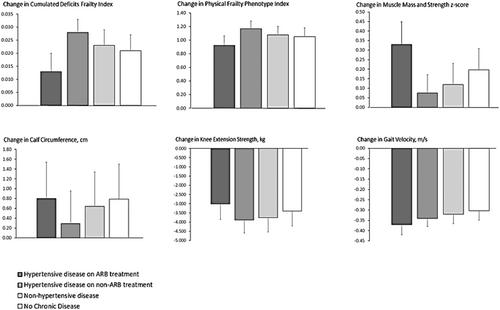Angiotensin receptor blockers use and changes in frailty, muscle mass, and function indexes: Singapore Longitudinal Ageing Study
Abstract
Background
Pre-clinical studies suggest that renin–angiotensin system blockade may improve muscle function. Clinical reports of the effect of angiotensin converting enzyme inhibitors (ACEIs) on physical functioning are inconsistent. There are no reports of the effect of angiotensin receptor blockers (ARBs) treatment in older adults.
Methods
We analysed data of 1268 participants in the Singapore Longitudinal Ageing Study (SLAS-2) who provided information on the use of ACEI, ARB, and other antihypertensive drugs at baseline and follow-up (mean 4.5 years later). Baseline and follow-up outcome measures were cumulated deficits frailty index (CD-FI), physical phenotype frailty index (PP-FI), calf circumference (CC), knee extension strength, composite muscle mass and strength (MMS) z-score, and gait speed (GS). In primary analyses, we compared the use and non-use of an anti-hypertensive drug class among participants with hypertensive and cardiac disease, and secondarily with participants having other chronic diseases, and those who reported no chronic diseases. Multi-variable analyses adjusted for socioeconomic status, body mass index ≥30, ≥5 comorbidities, ≥5 drugs use, other non-ARB or non-ACEI drugs (calcium channel blockers, beta blockers, or hydrochlorothiazide), MMSE <23, Geriatric Depression Scale score, Nutrition Screening Initiative nutritional risk, physical activities, baseline frailty, and physical performance.
Results
Among study participants, 7.8% (N = 99) were ARB users (62% used losartan), 11.7% (N = 148) were ACEI users (53% used enalapril), and 34.2% (N = 434) were users of other anti-hypertensive drug classes. The cohort participants overall showed increases in the mean levels and changes in CD-FI and PP-FI and decreases in knee extension strength, GS, CC, and MMS. However, among groups, ARB users showed decreasing trends in CD-FI and increasing trends of CC and MMS. Among participants with hypertensive and cardiovascular disease, there were significant differences in CD-FI and PP-FI changes, adjusted for confounding variables: ARB users compared with non-users showed lesser declines in CD-FI (0.013 vs. 0.028, P = 0.018) and PP-FI (0.924 vs. 1.170, P = 0.017). ARB users also showed statistically significantly greater gains in MMS z-scores: 0.329 vs. 0.076, P = 0.022. There was no association of ACEI or other anti-hypertensive class use with changes in frailty, MMS, or GS.
Conclusions
The use of ARBs is associated with a reduction in frailty and age-related loss of muscle mass and strength.


 求助内容:
求助内容: 应助结果提醒方式:
应助结果提醒方式:


